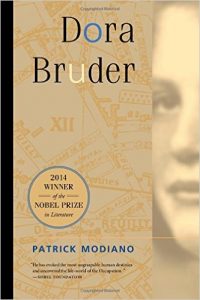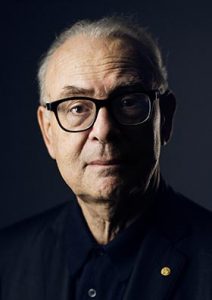Nobel Prize Winner Patrick Modiano’s Dora Bruder
 Last year when the Nobel Prize in Literature went to Bob Dylan, many people responded with the question, Why? Two years earlier when the Nobel Prize committee named Patrick Modiano the recipient of its literature prize, another question was often asked, Who?
Last year when the Nobel Prize in Literature went to Bob Dylan, many people responded with the question, Why? Two years earlier when the Nobel Prize committee named Patrick Modiano the recipient of its literature prize, another question was often asked, Who?
Though Modiano had published about thirty works in his native France, he was almost unknown in this country. Only a dozen of his novels had been translated into English, and the publishing house David R. Godine, which had published three of them, sold only about 8,000 copies.
The Nobel Prize changed that, and we readers are the beneficiaries.
In announcing his award, the prize committee said it “was for the art of memory with which he has evoked the most ungraspable human destinies and uncovered the life-world of the occupation.”
Memory is a central character in Modiano’s books, as is his hometown of Paris. His interest in both is bound up in the year of his birth, he said in his Nobel lecture: “Being born in 1945, after the cities had been destroyed and entire populations had disappeared, must have made me, like others of my age, more sensitive to the themes of memory and oblivion.”
Paris, memory, and loss are powerfully evoked in Dora Bruder, a deceptively slight book, translated by Joanna Kilmartin. At 119 pages, you could read it in one sitting, but however long it takes to read, it will stay with you, seep into you, and haunt you.
The story line appears simple. Modiano undertakes to discover what happened to a young Jewish girl in Paris when she failed to return to her school on the last day of the year in 1941. Modiano, the narrator, begins the book:
“Eight years ago, in an old copy of Paris-Soir, dated 31 December 1941, a heading on page 3 caught my eye: ‘From Day to Day.’ Below this I read: ‘Paris. Missing, a young girl, Dora Bruder, age 15.’” The notice describes her physical appearance and clothing and gives the address for notifying her parents, 41 Boulevard Ornano.
 Modiano remembers Boulevard Ornano from his youth, first when he visited flea markets with his mother, then when riot police stood guard during the situation in Algeria, and later when he visited a girlfriend. He remembers the shops, the weather, and the time over different years and in different seasons. “I’ve never really noticed the building beside the cinema, number 41, even though I’ve been passing it for months, for years. From 1965 to 1968.”
Modiano remembers Boulevard Ornano from his youth, first when he visited flea markets with his mother, then when riot police stood guard during the situation in Algeria, and later when he visited a girlfriend. He remembers the shops, the weather, and the time over different years and in different seasons. “I’ve never really noticed the building beside the cinema, number 41, even though I’ve been passing it for months, for years. From 1965 to 1968.”
Time and memories begin to work on him. “From day to day, with the passage of time, I find, perspectives become blurred, one winter merging into another. That of 1965 and that of 1942.” In his youth, in 1965, “Perhaps, though not yet fully aware of it, I was following the traces of Dora Bruder and her parents. Already, below the surface, they were there.”
As we read, we learn that Dora’s parents were Austrian and Hungarian Jews, who had enrolled their daughter in a Catholic boarding school. How did they hear of it, why did they send her there, and why would a Jewish child have escaped that safety? Where could she go in Nazi-occupied Paris? Where do you hide in a world gone mad?
Modiano finds fragments of information here and there but few answers.
“It takes time for what has been erased to resurface,” Modiano writes. Traces survive in registers, and nobody knows where these registers are hidden, and who has custody of them, and whether or not these custodians are willing to let you see them. Or perhaps they have quite simply forgotten that these registers exist.
“All it takes is a little patience.”
We learn some facts: The young girl left her parents’ home but did not return the school, the notice appeared in the paper, she was captured four months later and interned in a camp from which she was transported to Auschwitz, where she was killed. What happened in from January to April is not known. Modiano searches.
His thoughts move back to 1941 and 1942, years he didn’t live, and to the 1960s and 1970s, years he did. In precise language, often with specific details but also with musings and speculation, he bridges time and connects his past with Dora’s past.
It would be too pat to say that Modiano succeeds in bringing to life a child lost to history. We learn as much about Modiano as we do about Dora Bruder, if not more. Modiano never discovers why she didn’t return to school or what happened before her internment. The power in the book is from the elegant way in which he blends the history of the 1940s with his own history and his compulsion to have history account for itself. His desire to know what happened to Bruder and other anonymous people becomes our desire.
Dora Bruder is labeled fiction in the bookstores I’ve checked, but I agree with reviewers who say it’s not so easily labeled. “While there are a few ‘novelistic’ moments in it,” writes Susan Rubin Suleiman, in a 2006 lecture about Modiano,” the book is powerful–and ethically compelling– precisely because it is not a novel but a work that combines historical documentation with imaginative reflection and self-reflection.”
The narrator can’t discover the truth of Bruder’s life and his search for parallels with his own can go only so far. So much has been lost through the years, but with Dora Bruder, some of what had been erased resurfaced in Modiano’s beautiful and moving book.
Janet Willen
Janet Willen is author of Speak a Word for Freedom: Women against Slavery (2015) and Five Thousand Years of Slavery (2011), written with Marjorie Gann and published by Tundra Books. Publishers Weekly called Speak a Word for Freedom an “engrossing study of female abolitionists from the 18th century to the present day” and gave the book a starred review. Five Thousand Years of Slavery was named a 2012 Notable Book for a Global Society by the International Reading Association and a Silver Winner in young adult nonfiction of ForeWord Reviews, and it received a starred review from School Library Journal. A writer and editor for more than thirty years, Janet has written many magazine articles and has edited books for elementary school children as well as academic texts and a remedial writing curriculum for postsecondary students. Janet lives in Silver Spring, Maryland.